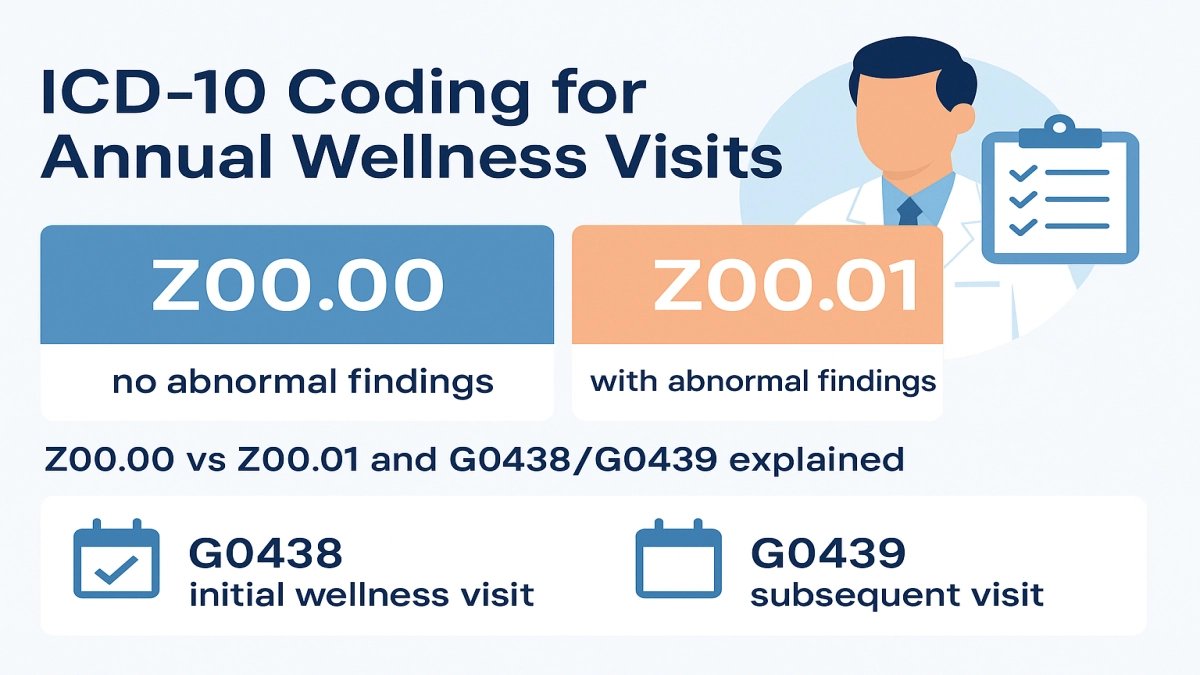The Annual Wellness Visit (AWV) is more than a simple check-up, it’s a preventive service designed to create a personalized roadmap for better health. But behind this routine-sounding appointment lies a crucial aspect of medical billing: accurate ICD 10 coding.
In this guide, we’ll unravel what the ICD 10 for annual wellness visit entails, how it’s used, why it matters, and how to ensure compliant, optimized billing whether you’re in a clinic, private practice, or healthcare system.
What Is an Annual Wellness Visit?
An Annual Wellness Visit is a Medicare-covered service introduced under the Affordable Care Act to promote preventive healthcare for eligible beneficiaries. Unlike a traditional physical exam, an AWV focuses on:
- Reviewing medical and family history
- Developing/updating a personalized prevention plan
- Cognitive impairment screening
- Depression risk assessment
- Advance care planning (if desired)
Patients are eligible once per year, and the visit is not subject to copay or deductible, if billed correctly.
Understanding ICD 10 for Annual Wellness Visit
While the Current Procedural Terminology (CPT) codes handle the services performed (like G0438 and G0439), ICD-10 codes explain why those services were necessary.
The most commonly used ICD-10 code for AWVs is:
Z00.00 – Encounter for general adult medical examination without abnormal findings
If abnormal findings are present, the alternative is:
Z00.01 – Encounter for general adult medical examination with abnormal findings
Both fall under the “Z” category, which encompasses health status and contact with health services—ideal for preventive visits.
Top ICD 10 Codes for Annual Wellness Visit
Below are the most used and accepted ICD 10 codes associated with AWV, depending on clinical context:
| ICD 10 Code | Description |
|---|---|
| Z00.00 | Adult medical exam without abnormal findings |
| Z00.01 | Adult medical exam with abnormal findings |
| Z13.1 | Screening for diabetes mellitus |
| Z13.6 | Screening for cardiovascular disorders |
| Z13.89 | Screening for mental health disorders |
| Z91.89 | Other specified personal risk factors |
| Z63.4 | Disappearance/loss of family member (for social risk screenings) |
Tip for billers: Use Z00.00 or Z00.01 as your primary diagnosis. Use others as secondary if screening or risk factors are addressed.
How to Use ICD 10 for Annual Wellness Visit in Billing
Step-by-Step Approach:
- Determine the Visit Type
- Initial AWV = Use CPT G0438
- Subsequent AWV = Use CPT G0439
- Match the ICD 10 Code to Documentation
- Z00.00 if no new symptoms or abnormal findings
- Z00.01 if provider identifies any new concern
- Add Supporting Codes (if applicable)
Include codes for depression screening, social risk factors, or chronic condition management when discussed. - Double Check for Comorbidity
If managing an ongoing condition (e.g., hypertension), add that code (e.g., I10) after the Z-code.
Comparing ICD 10 for Annual Wellness Visit vs Other Codes
Many confuse AWV codes with those used for physicals or problem-based visits. Here’s a quick comparison:
| Type of Visit | ICD 10 | CPT |
|---|---|---|
| Annual Wellness Visit | Z00.00 / Z00.01 | G0438 / G0439 |
| Welcome to Medicare Visit | Z00.00 / Z00.01 + Z00.6 | G0402 |
| Problem-Based Visit | Based on diagnosis (e.g., J02.9) | 99213 – 99215 |
| Commercial Preventive Visit | Varies by insurer | 99385–99397 |
Mislabeling these visits is one of the top causes of claim denials.
Benefits of Accurate ICD 10 Use for Annual Wellness Visit
- Prevents reimbursement errors
- Avoids triggering audits
- Supports care coordination
- Provides data for population health tracking
- Reinforces Medicare compliance
Billing Z00.01 when no abnormal findings are documented? That’s a red flag for a payer.
Best Practices for Using ICD 10 for Annual Wellness Visit
- Always review the provider’s documentation before choosing Z00.00 vs Z00.01
- Keep up with Medicare guidelines, which update annually
- Use secondary diagnosis codes when screenings or counseling occur
- Educate providers on the difference between AWVs and physicals
- If abnormalities are found and addressed, a problem visit CPT code may also be billed—but only with appropriate modifier (-25) and documentation
Common Errors When Using ICD 10 for AWV
- Using Z00.01 without supporting documentation
- Bypassing social risk factors, even when they’re addressed
- Billing G0439 when it’s a patient’s first AWV
- Forgetting to list chronic conditions that were reviewed or managed
Reviews of ICD 10 for Annual Wellness Visit Coding
Many medical billing professionals report that AWV billing is straightforward once the ICD/CPT pairing is understood, but easy to mess up if you rely too heavily on EHR default templates.
Consider adding real-life billing scenarios or quotes from coders who handle Medicare regularly.
ICD 10 for Annual Wellness Visit Alternatives and Related Codes
Some related scenarios and coding approaches include:
- Preventive physicals for non-Medicare patients (use 99396 + Z00.00)
- Commercial wellness exams with more focus on physical assessment
- Telehealth AWVs, now more common post-pandemic (same CPT/ICD combo applies, with place of service 02 or 10)
Actionable Takeaways
- Use Z00.00 as your default AWV diagnosis code—change to Z00.01 only when findings are documented.
- Always match ICD 10 codes to clinical notes and CPTs to the visit type.
- Include supporting diagnosis codes for screenings, risk factors, or chronic conditions.
- Educate your team on ICD 10 vs CPT responsibilities to reduce billing errors.

